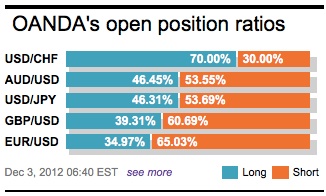This week is doing its best to start on the correct foot, helped mostly by Greek buy-back plans and by positive Chinese manufacturing data. This month will not end up being a sprint to the ‘turn’ as liquidity and market participation will quickly fall off by mid-month, providing more unnecessary obstacles when trying to finish out the year. There will be a plethora of event risk and fundamental announcements to bypass before we can safely close out this Central Bank dominated trading year. Despite the month of December ending up being sparse of participants and thin on the ground with liquidity, patience will end up being a trading virtue for many investors.
Greek bond values have surged and the single currency has strengthened outright after the Greek government announced a plan to buy-back up to +EUR10b of their country’s outstanding debt. The buy-back prices were much higher than most investors had expected. The government has said they would purchase their own bonds from private bondholders at below face value to get their ‘debt on a more sustainable footing.’ Investors, who decide to sell back, will in return get notes issued by the EFSF at agreed upon purchase price. The agreed price this morning far exceeds the indicative price that the Euro-group indicated last week. Despite the current prices being below the max range of buy-back value (30.2% to 38.1%), the Greek bonds still have room to move higher before this Friday’s buy-back deadline.

China once again is aiding market risk as the country’s official PMI rose to a seven-month high of 50.6 last month, remaining in expansion territory and up from 50.2 the previous month. Despite the overall stronger reading, concerns over the crucial US budget negotiations continue to weigh on the markets and will most likely remain a headwind until we get greater transparency of the situation Stateside.
Unlike the world’s second largest economy, Euro-manufacturing contracted for a ninth consecutive month in November (46.2 vs. 45.4). Demand in the region obviously remains weak, however, the market should take solace in the fact that the downturn is at the slowest rate in eight-months. The ongoing steep pace of the Euro-zones manufacturing decline suggests that the regions recession will again deepen in the final quarter of this year. Stateside, analysts expect the US manufacturing ISM to ease moderately to around 51 later this morning. Hurricane Sandy should boost the headline, however, seasonals could point to a weaker reading on new-orders. No-matter, the data is likely to be viewed as consistent with a moderate recovery.
How many Euro-group meeting do we need to have? Their finance minister’s meet again today, however, with a broad agreement on the next phase of Greece support already reached, there is less chance for them to do any market harm! A few CBanks are meeting this week and again the market is on ECB watch. The consensus thus far is that the recent upturn in PMI data and the Ifo make it likely that that policy makers will again choose to leave policy unchanged. It would seem that the market is leaning towards the next ECB move of a 25-50bp cut to the repo rate, most likely in Q1. At least we can be sure to expect Draghi to drone on about growth risks in the press conference afterwards.
This evening’s RBA rate call is going to be a close one. It seems a boisterous few believe that the Aussie policy makers could still be leaning towards a cut Tuesday by -25bp to +3%. However, nothing fundamentally has changed since last months ‘no’ rate call. The RBA still expects the investment boom in the mining sector to end earlier than previously assumed and that other sectors like the export and tourism area may also require additional help. With Aussie policy makers preferring to be proactive means a surprise ends up being no surprise!

The EUR has found itself in new territory. The single currency looks to have room for further upside movement as the short positions in EUR remain significant and the recent upwind of further bets against the currency could push the EUR outright higher. However, despite the upper Bollinger prices remaining in striking distance (1.3049), price action was held in check overnight. It seems that the hourly studies have eased from overbought levels, but the pullbacks are expected to hold above 1.30 for now despite it being possible that the USD could benefit from the risk adverse trades if the Euro-zone debt concerns flare up. Be weary that the further we go deeper into the month of December, fundamentals and technical can sometimes be easily tossed to the wayside!

Other Links:
Has the EUR the Green Light to Pass “Go”?
This article is for general information purposes only. It is not investment advice or a solution to buy or sell securities. Opinions are the authors; not necessarily that of OANDA Corporation or any of its affiliates, subsidiaries, officers or directors. Leveraged trading is high risk and not suitable for all. You could lose all of your deposited funds.


